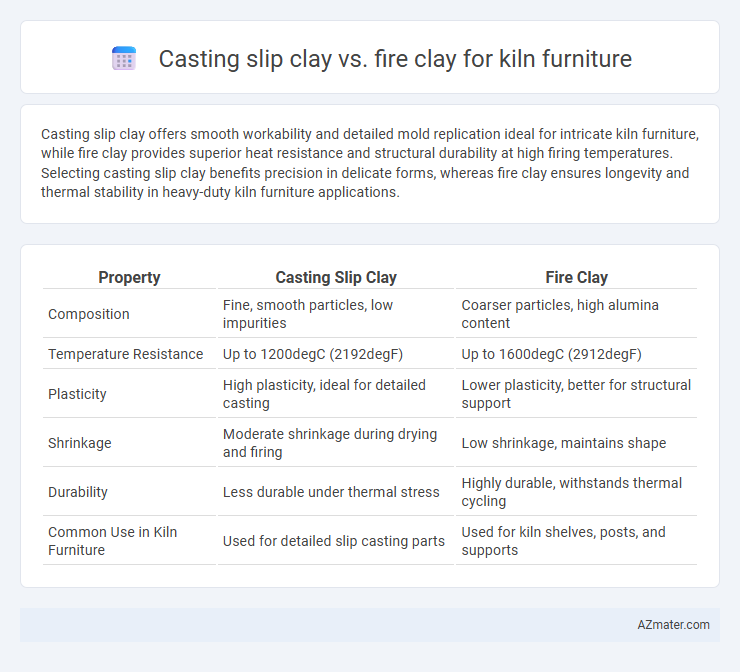Casting slip clay offers smooth workability and detailed mold replication ideal for intricate kiln furniture, while fire clay provides superior heat resistance and structural durability at high firing temperatures. Selecting casting slip clay benefits precision in delicate forms, whereas fire clay ensures longevity and thermal stability in heavy-duty kiln furniture applications.
Table of Comparison
| Property | Casting Slip Clay | Fire Clay |
|---|---|---|
| Composition | Fine, smooth particles, low impurities | Coarser particles, high alumina content |
| Temperature Resistance | Up to 1200degC (2192degF) | Up to 1600degC (2912degF) |
| Plasticity | High plasticity, ideal for detailed casting | Lower plasticity, better for structural support |
| Shrinkage | Moderate shrinkage during drying and firing | Low shrinkage, maintains shape |
| Durability | Less durable under thermal stress | Highly durable, withstands thermal cycling |
| Common Use in Kiln Furniture | Used for detailed slip casting parts | Used for kiln shelves, posts, and supports |
Introduction to Kiln Furniture Materials
Casting slip clay offers fine particle size and smooth consistency, making it ideal for detailed shapes in kiln furniture. Fire clay, known for its high refractory properties and durability, withstands extreme kiln temperatures without deformation. Selecting the right material ensures optimal thermal resistance and mechanical strength during firing cycles.
What is Casting Slip Clay?
Casting slip clay is a finely milled, liquid clay mixture used to create detailed ceramic pieces through slip casting, offering smooth surfaces and high precision ideal for complex kiln furniture components. Fire clay, known for high refractory properties and resistance to thermal shock, is commonly employed in kiln furniture but lacks the fluidity and fine detail achievable with casting slip clay. The choice between casting slip clay and fire clay depends on the desired precision and thermal performance of kiln furniture in high-temperature firing environments.
What is Fire Clay?
Fire clay, a highly refractory material with a melting point above 1,750degC, is essential for kiln furniture due to its excellent heat resistance and durability under thermal stress. Unlike casting slip clay, fire clay contains higher alumina and silica content, enabling it to withstand repeated firing cycles without deforming or cracking. Its unique composition makes it ideal for supporting heavy ceramic pieces during firing, ensuring structural stability in high-temperature kiln environments.
Physical Properties: Casting Slip Clay vs Fire Clay
Casting slip clay exhibits higher plasticity and finer particle size, enabling precise molding and smooth surface finishes essential for intricate kiln furniture designs. Fire clay displays superior heat resistance and refractory strength, maintaining structural integrity under prolonged high-temperature conditions within kilns. The denser, less porous nature of fire clay ensures enhanced durability, whereas casting slip clay offers better workability but may require additional treatments to withstand thermal stress.
Thermal Performance in Kiln Environments
Casting slip clay offers superior thermal shock resistance and higher porosity, allowing better insulation and rapid heat distribution in kiln furniture applications. Fire clay, characterized by its dense and fine-grained structure, provides excellent high-temperature stability and durability under prolonged exposure to extreme kiln environments. Selecting casting slip clay enhances thermal performance by reducing thermal stress, whereas fire clay ensures structural integrity during sustained high-heat operations.
Durability and Longevity Comparison
Casting slip clay offers moderate durability with a fine texture suitable for detailed kiln furniture, but it tends to be less resistant to thermal shock and mechanical stress compared to fire clay. Fire clay exhibits superior durability and longevity due to its high alumina content and excellent thermal stability, making it ideal for heavy-duty kiln furniture exposed to repeated firing cycles. The enhanced resistance of fire clay to cracking and deformation ensures longer service life and reduced replacement frequency in high-temperature kiln environments.
Workability and Shaping Techniques
Casting slip clay exhibits superior workability due to its fine particle size and smooth consistency, allowing for precise, detailed shaping through slip casting or mold pouring techniques. Fire clay, being coarser and more refractory, is less fluid but excels in hand-building and extrusion methods for kiln furniture requiring high thermal resistance. The choice between casting slip and fire clay hinges on the desired balance between shaping ease and high-temperature durability in kiln furniture production.
Cost Considerations and Availability
Casting slip clay is generally more cost-effective than fire clay for kiln furniture due to lower material and processing expenses, making it suitable for large-scale production with budget constraints. Fire clay, while more expensive and less readily available, offers superior refractory properties and durability, which can reduce replacement frequency and maintenance costs over time. Availability of casting slip clay is higher as it is widely produced and distributed, whereas fire clay may require sourcing from specialized suppliers, impacting lead times and overall project costs.
Suitability for Different Kiln Furniture Applications
Casting slip clay offers excellent fluidity, making it ideal for intricate kiln furniture shapes or molds requiring high precision and detail. Fire clay, known for its high refractory properties and durability, is better suited for heavy-duty kiln furniture subjected to frequent thermal cycling and mechanical stress. Choosing the right clay depends on the kiln furniture's specific application, balancing between detailed casting needs and robust structural performance.
Choosing the Right Clay for Your Kiln Furniture
Casting slip clay offers excellent workability and fine detail capture, making it ideal for intricate kiln furniture designs that require precision. Fire clay is distinguished by its high refractory properties and thermal stability, ensuring durability and resistance to warping at extreme kiln temperatures. Selecting the right clay involves balancing the casting slip's ease of molding with fire clay's superior heat endurance to optimize the performance and lifespan of your kiln furniture.

Infographic: Casting slip clay vs Fire clay for Kiln furniture
 azmater.com
azmater.com